Life Cycle Impacts of Recycling of Black Mass Obtained from End-of-Life Zn-C and Alkaline Batteries Using Waelz Kiln
Abstract
1. Introduction
2. Materials and Methods
2.1. Goal and Scope Definition
2.1.1. Scenario 1—Black Mass as a Co-Substrate in Steelmaking Dust Processing in a Waelz Kiln
2.1.2. Scenario 2—Waste-Free Technology of Black Mass Processing in Waelz Kiln
2.2. Life Cycle Inventory Analysis (LCI)
3. Results and Discussion
3.1. Scenario 1
3.2. Scenario 2
3.3. Comparison
4. Summary
Supplementary Materials
Author Contributions
Funding
Conflicts of Interest
References
- ROADMAP ON RAW MATERIALS Prepared by Working Group 2 # BatteriesEurope. 2021. Available online: https://energy.ec.europa.eu/system/files/2021-12/vol-2-009.pdf (accessed on 11 June 2022).
- Karnchanawong, S.; Limpiteeprakan, P. Evaluation of heavy metal leaching from spent household batteries disposed in municipal solid waste. Waste Manag. 2009, 29, 550–558. [Google Scholar] [CrossRef] [PubMed]
- Ebin, B.; Petranikova, M.; Steenari, B.M.; Ekberg, C. Production of zinc and manganese oxide particles by pyrolysis of alkaline and Zn-C battery waste. Waste Manag. 2016, 51, 157–167. [Google Scholar] [CrossRef] [PubMed]
- Maryam Sadeghi, S.; Jesus, J.; Soares, H.M.V.M. A critical updated review of the hydrometallurgical routes for recycling zinc and manganese from spent zinc-based batteries. Waste Manag. 2020, 113, 342–350. [Google Scholar] [CrossRef] [PubMed]
- Pang, L.; Wang, D.; Wang, H.; An, M.; Wang, Q. Occurrence and leaching behaviors of heavy-metal elements in metallurgical slags. Constr. Build. Mater. 2022, 330, 127268. [Google Scholar] [CrossRef]
- Minakshi, M.; Mitchell, D.R.G.; Prince, K. Incorporation of TiB2 additive into MnO2 cathode and its influence on rechargeability in an aqueous battery system. Solid State Ionics 2008, 179, 355–361. [Google Scholar] [CrossRef]
- Minakshi, M.; Singh, P.; Sharma, N.; Blackford, M.; Ionescu, M. Lithium Extraction−Insertion from/into LiCoPO4 in Aqueous Batteries. Ind. Eng. Chem. Res. 2011, 50, 1899–1905. [Google Scholar] [CrossRef]
- Belardi, G.; Ballirano, P.; Ferrini, M.; Lavecchia, R.; Medici, F.; Piga, L.; Scoppettuolo, A. Characterization of spent zinc–carbon and alkaline batteries by SEM-EDS, TGA/DTA and XRPD analysis. Thermochim. Acta 2011, 526, 169–177. [Google Scholar] [CrossRef]
- Łukomska, A.; Wiśniewska, A.; Dąbrowski, Z.; Kolasa, D.; Luchcińska, S.; Lach, J.; Wróbel, K.; Domańska, U. Recovery of zinc and manganese from “black mass” of waste Zn-MnO2 alkaline batteries by solvent extraction technique with ionic liquids, DESs and organophosphorous-based acids. J. Mol. Liq. 2021, 338, 116590. [Google Scholar] [CrossRef]
- Ebin, B.; Petranikova, M.; Steenari, B.M.; Ekberg, C. Effects of gas flow rate on zinc recovery rate and particle properties by pyrolysis of alkaline and zinc-carbon battery waste. J. Anal. Appl. Pyrolysis 2016, 121, 333–341. [Google Scholar] [CrossRef]
- Sayilgan, E.; Kukrer, T.; Civelekoglu, G.; Ferella, F.; Akcil, A.; Veglio, F.; Kitis, M. A review of technologies for the recovery of metals from spent alkaline and zinc–carbon batteries. Hydrometallurgy 2009, 97, 158–166. [Google Scholar] [CrossRef]
- Tran, H.P.; Schaubroeck, T.; Swart, P.; Six, L.; Coonen, P.; Dewulf, J. Recycling portable alkaline/ZnC batteries for a circular economy: An assessment of natural resource consumption from a life cycle and criticality perspective. Resour. Conserv. Recycl. 2018, 135, 265–278. [Google Scholar] [CrossRef]
- Sposób Wytwarzania Koncentratu Manganu i Koncentratu Cynku. Polish Patent 233701, 24 July 2019.
- Silvestri, L.; Forcina, A.; Arcese, G.; Bella, G. Recycling technologies of nickel–metal hydride batteries: An LCA based analysis. J. Clean. Prod. 2020, 273, 123083. [Google Scholar] [CrossRef]
- Fahimi, A.; Ducoli, S.; Federici, S.; Ye, G.; Mousa, E.; Frontera, P.; Bontempi, E. Evaluation of the sustainability of technologies to recycle spent lithium-ion batteries, based on embodied energy and carbon footprint. J. Clean. Prod. 2022, 338, 130493. [Google Scholar] [CrossRef]
- Wu, F.; Li, L.; Crandon, L.; Cao, Y.; Cheng, F.; Hicks, A.; Zeng, E.Y.; You, J. Environmental hotspots and greenhouse gas reduction potential for different lithium-ion battery recovery strategies. J. Clean. Prod. 2022, 339, 130697. [Google Scholar] [CrossRef]
- Sydow, M.; Chrzanowski, Ł.; Hauschild, M.Z.; Owsianiak, M. Influence of metal speciation on soil ecotoxicity impacts in life cycle assessment. J. Environ. Manag. 2020, 266, 110611. [Google Scholar] [CrossRef] [PubMed]
- ISO 14040:2006; Environmental Management—Life Cycle Assessment—Principles and Framework. International Organization for Standardization: Geneva, Switzerland, 2006.
- Owsianiak, M.; Holm, P.E.; Fantke, P.; Christiansen, K.S.; Borggaard, O.K.; Hauschild, M.Z. Assessing comparative terrestrial ecotoxicity of Cd, Co, Cu, Ni, Pb, and Zn: The influence of aging and emission source. Environ. Pollut. 2015, 206, 400–410. [Google Scholar] [CrossRef] [PubMed]
- Pikoń, K.; Krawczyk, P.; Badyda, K.; Bogacka, M. Predictive Analysis of Waste Co-Combustion with Fossil Fuels Using the Life Cycle Assessment (LCA) Methodology. Energies 2019, 12, 3691. [Google Scholar] [CrossRef]
- Huijbregts, M.A.J.; Steinmann, Z.J.N.; Elshout, P.M.F.; Stam, G.; Verones, F.; Vieira, M.; Zijp, M.; Hollander, A.; van Zelm, R. ReCiPe2016: A harmonised life cycle impact assessment method at midpoint and endpoint level. Int. J. Life Cycle Assess. 2017, 22, 138–147. [Google Scholar] [CrossRef]
- Ye, Y.; Magnusson, G.; Väänänen, M.; Tian, P. Recovery of Zn and Mn from spent alkaline batteries. In 9th International Symposium on High-Temperature Metallurgical Processing; Springer International Publishing: Cham, Switzerland, 2018; pp. 329–341. [Google Scholar]
- Bogacka, M.; Iluk, T.; Pikoń, K.; Ściążko, M.; Stec, M.; Czaplicki, A.; Wajda, A. Life Cycle Assessment (LCA) of the Use of Metallurgical Process Gas for Heat and Electricity, Combined with Salt Removal from Discarded Water. Sustainability 2022, 14, 1205. [Google Scholar] [CrossRef]
- Espinosa, D.C.R.; Bernardes, A.M.; Tenório, J.A.S. An overview on the current processes for the recycling of batteries. J. Power Sources 2004, 135, 311–319. [Google Scholar] [CrossRef]
- Rütten, J. Various Concepts for the Recycling of EAFD and Dust from Integrated Steel Mills. In Proceedings of the 3rd Seminar Networking between Zinc and Steel, Leoben, Austria, 2011; pp. 77–90. [Google Scholar]
- Ruh, A.; Krause, T. The Waelz Process in Europe. In 3. Seminar Networking between Zinc and Steel; Heft 125 der Schriftenreihe dre GDMB: Clausthal-Zellerfeld, Germany, 2011; pp. 35–46. [Google Scholar]
- Erakca, M.; Bautista, S.P.; Moghaddas, S.; Baumann, M.; Bauer, W.; Leuthner, L.; Weil, M. Closing gaps in LCA of lithium-ion batteries: LCA of lab-scale cell production with new primary data. J. Clean. Prod. 2022, 384, 135510. [Google Scholar] [CrossRef]
- Edelen, A.; Ingwersen, W.W. The creation, management, and use of data quality information for life cycle assessment. Int. J. Life Cycle Assess. 2017, 23, 759–772. [Google Scholar] [CrossRef] [PubMed]
- Jha, G.; Soren, S.; Mehta, K.D. Partial substitution of coke breeze with biomass and charcoal in metallurgical sintering. Fuel 2020, 278, 118350. [Google Scholar] [CrossRef]
- Di Maria, A.; Merchán, M.; Marchand, M.; Eguizabal, D.; De Cortázar, M.G.; Van Acker, K. Evaluating energy and resource efficiency for recovery of metallurgical residues using environmental and economic analysis. J. Clean. Prod. 2022, 356, 131790. [Google Scholar] [CrossRef]
- Klejnowska, K.; Pikoń, K.; Ścierski, W.; Skutil, K.; Bogacka, M. Influence of temperature on the composition and calorific value of gases produced during the pyrolysis of waste pharmaceutical blisters. Appl. Sci. 2020, 10, 737. [Google Scholar] [CrossRef]
- Sydow, M.; Chrzanowski, Ł.; Leclerc, A.; Laurent, A.; Owsianiak, M. Terrestrial ecotoxic impacts stemming from emissions of Cd, Cu, Ni, Pb and Zn from Manure: A spatially differentiated assessment in Europe. Sustainability 2018, 10, 4094. [Google Scholar] [CrossRef]
- Owsianiak, M.; Rosenbaum, R.K.; Huijbregts, M.A.J.; Hauschild, M.Z. Addressing geographic variability in the comparative toxicity potential of copper and nickel in soils. Environ. Sci. Technol. 2013, 47, 3241–3250. [Google Scholar] [CrossRef]
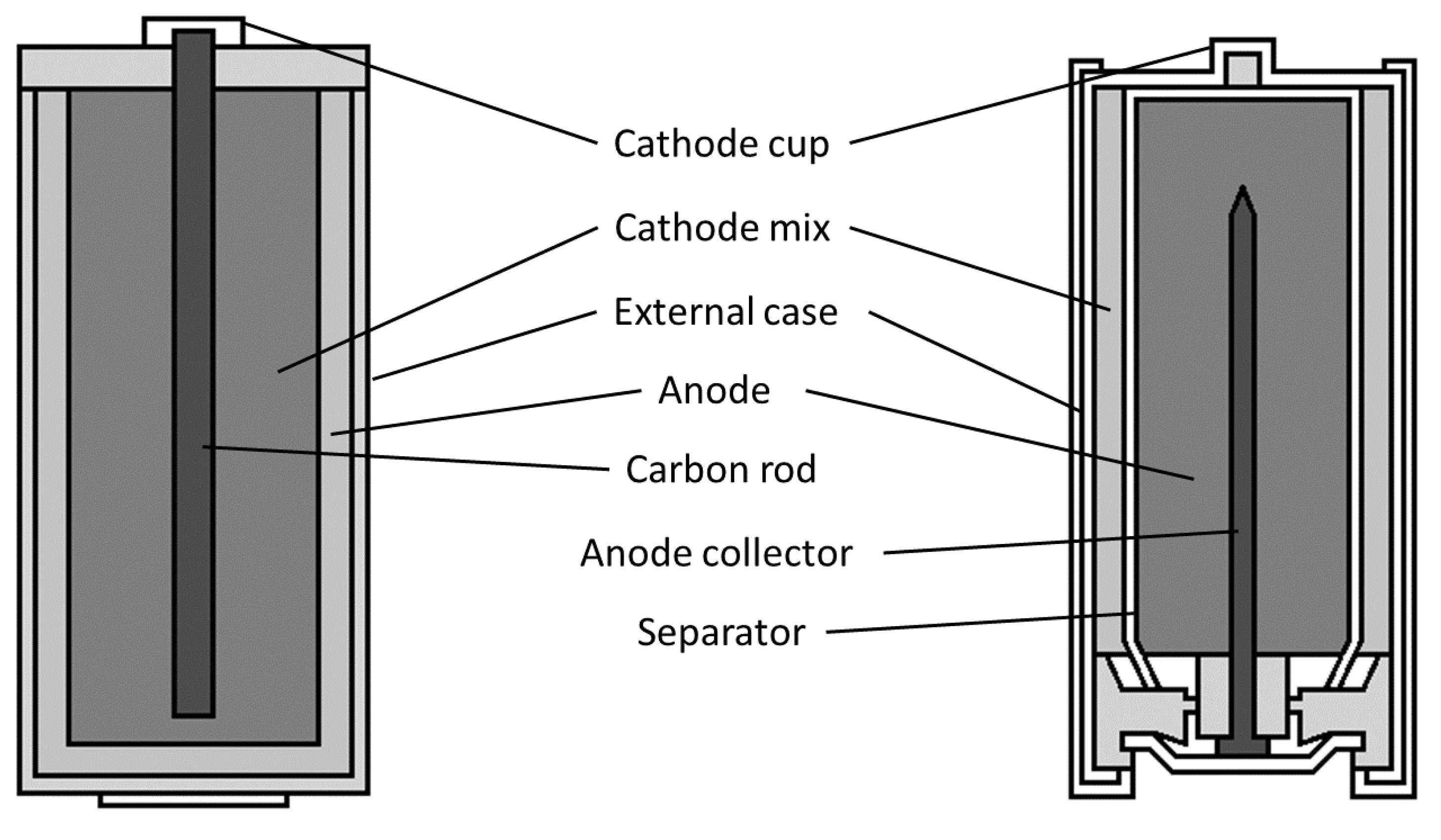
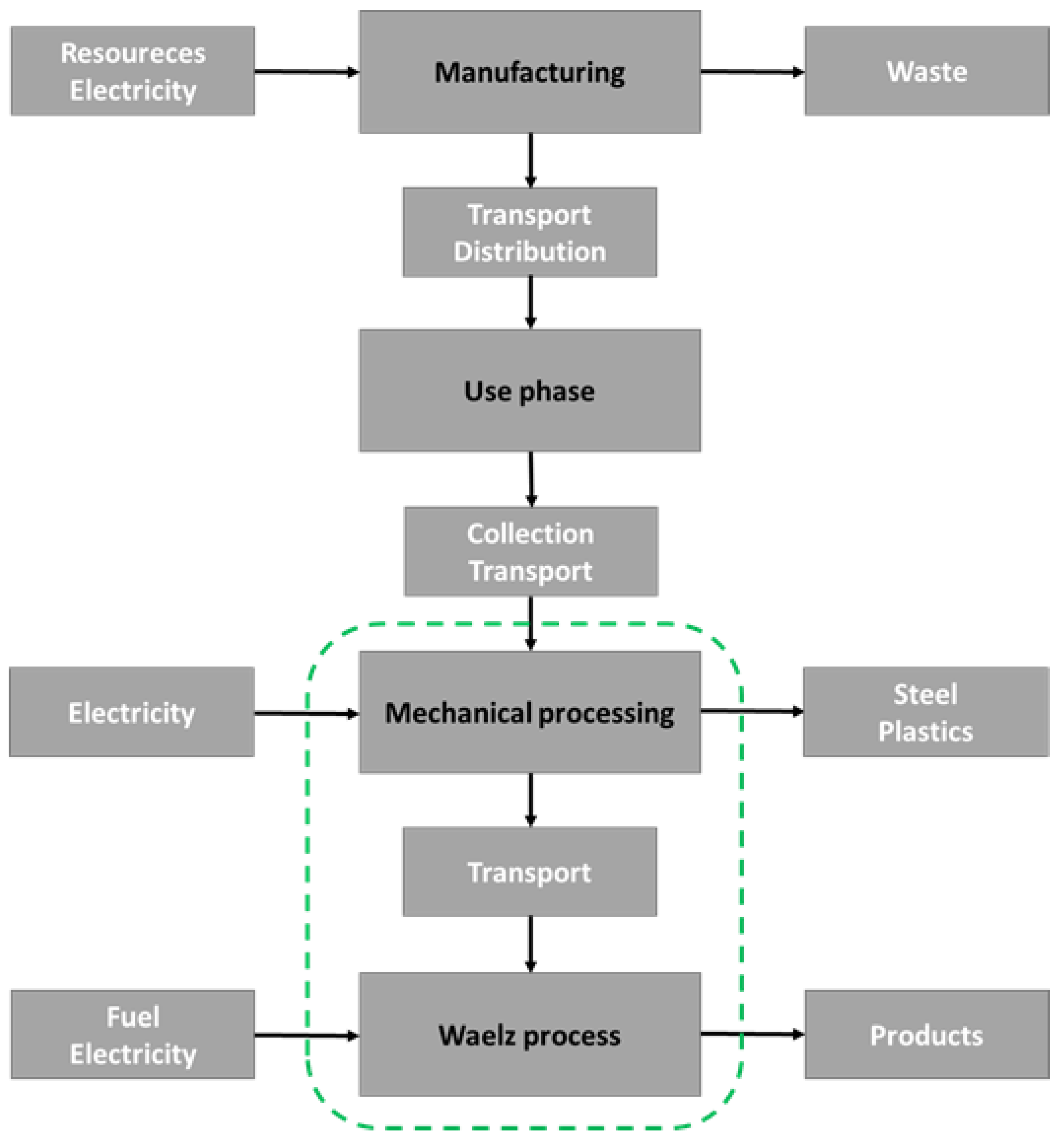
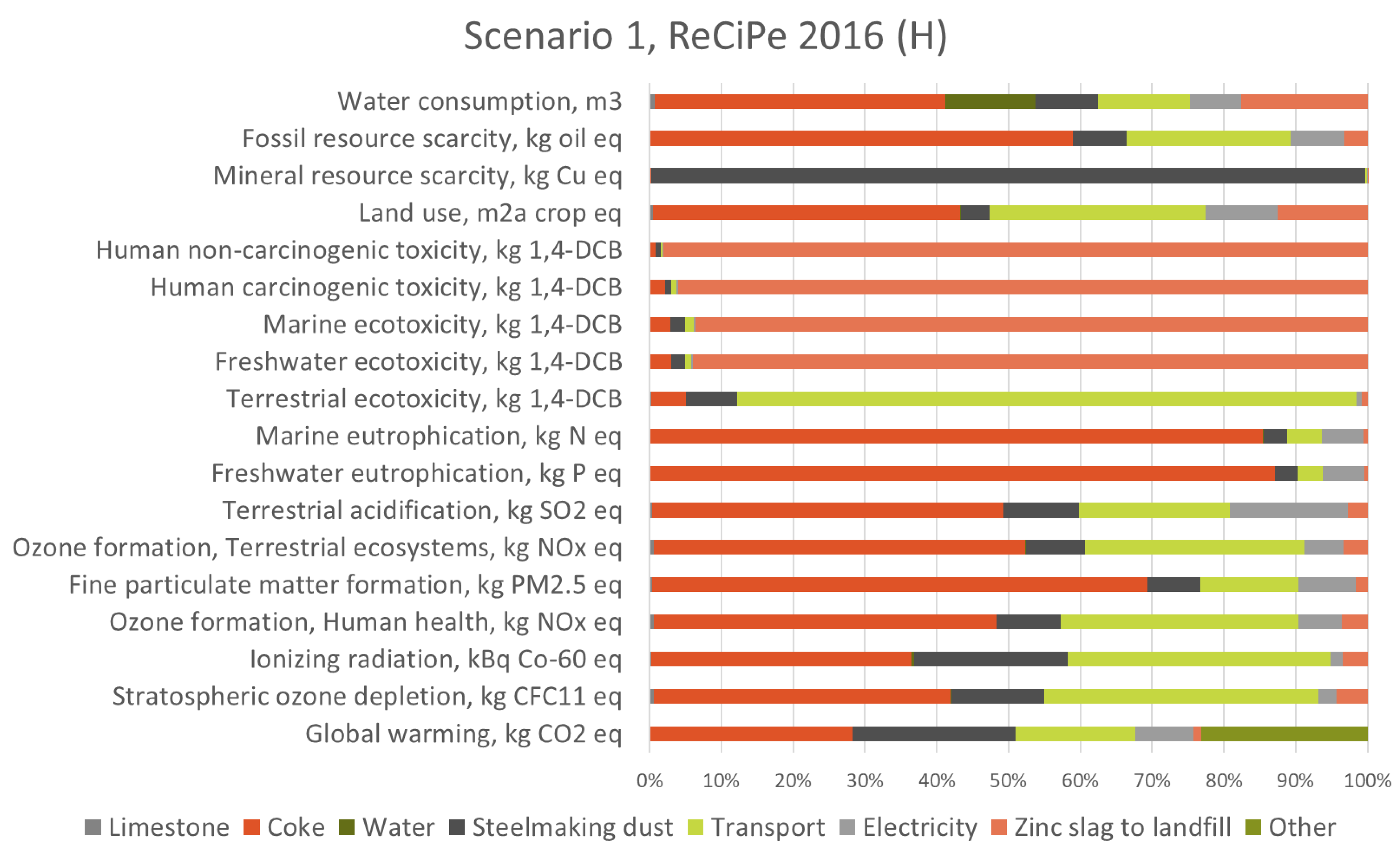

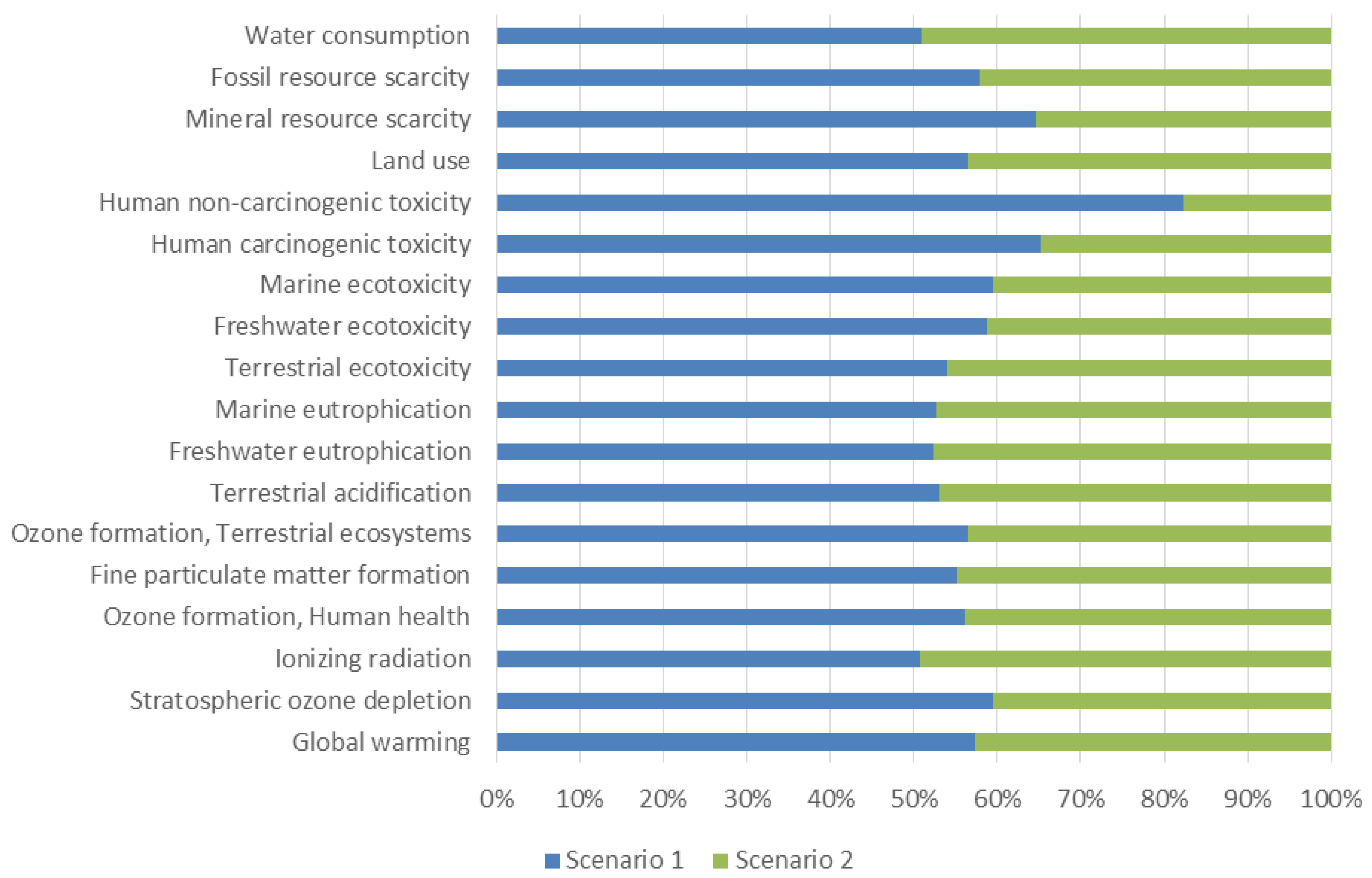
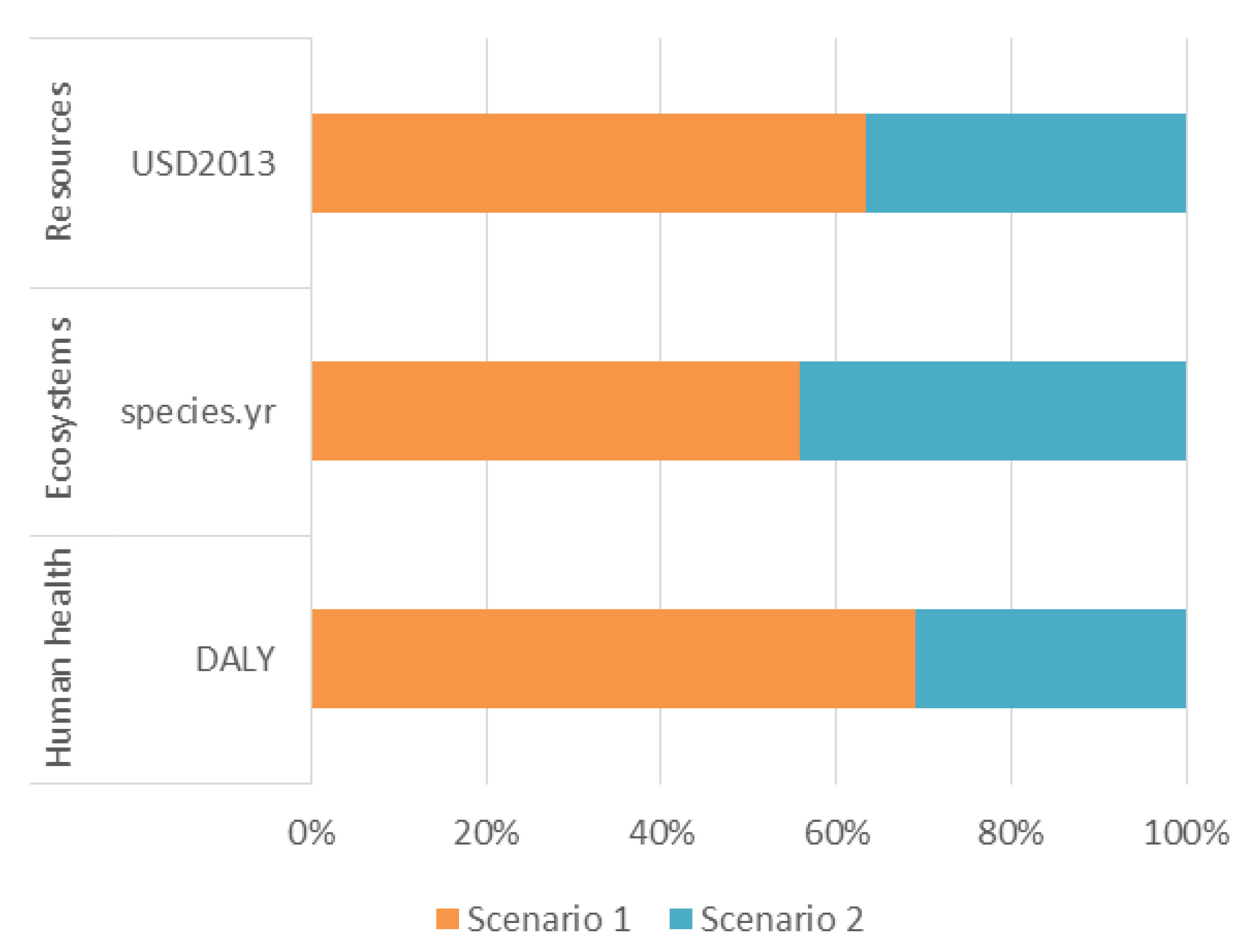
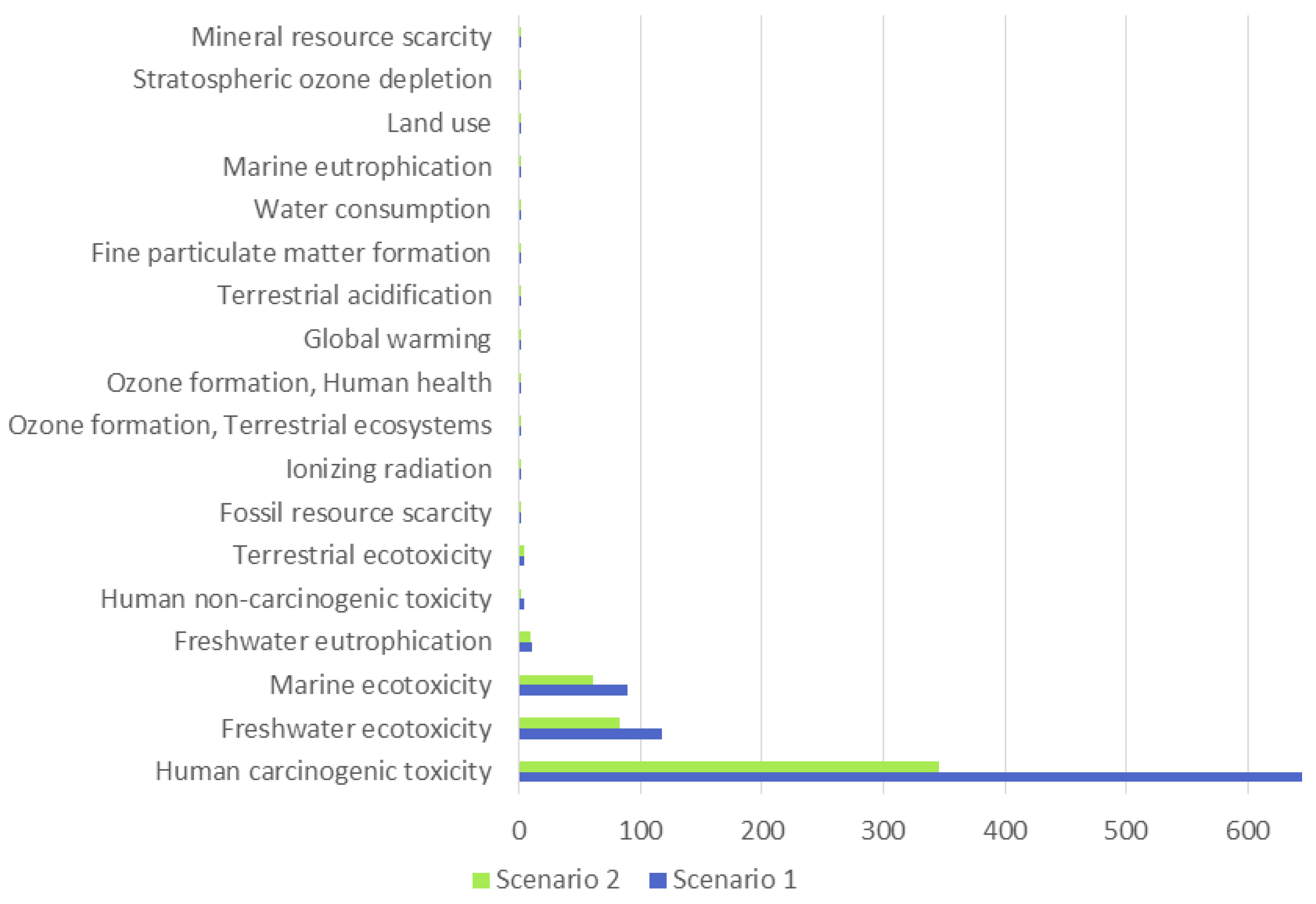
| LCI | Per 1 Mg of the Processed Black Mass: | |||
|---|---|---|---|---|
| Input | Unit | Scenario 1 | Scenario 2 | |
| Emissions to air | Oxygen, O2 | kg | 168.1 | 2.1 |
| Carbon dioxide, CO2 | kg | 605.1 | 13.67 | |
| Carbon monoxide, CO | kg | 33.6 | 3.4 | |
| Hydrogen, H2 | kg | - | 2.4 | |
| Nitrogen, N2 | kg | 2386.9 | 106.5 | |
| Steam | kg | 134.5 | - | |
| Material consumption | Natural gas | mn3/Mg | - | 20 |
| Coke | MJ | 23,969.4 | 6000 | |
| Black mass | kg | 1000 | 1000 | |
| Water | kg | 802.9 | - | |
| Steelmaking dusts | kg | 4662.5 | - | |
| Limestone | kg | 543.6 | - | |
| Oxygen, O2 | kg | 1509.6 | - | |
| Electricity | kWh | 175 | 175 | |
| Products | Zn concentrate | kg | - | 393 |
| Mn concentrate | kg | - | 479 | |
| Oxide material | kg | 2118.9 | - | |
| Waste slag | kg | 3836.9 | - | |
Disclaimer/Publisher’s Note: The statements, opinions and data contained in all publications are solely those of the individual author(s) and contributor(s) and not of MDPI and/or the editor(s). MDPI and/or the editor(s) disclaim responsibility for any injury to people or property resulting from any ideas, methods, instructions or products referred to in the content. |
© 2022 by the authors. Licensee MDPI, Basel, Switzerland. This article is an open access article distributed under the terms and conditions of the Creative Commons Attribution (CC BY) license (https://creativecommons.org/licenses/by/4.0/).
Share and Cite
Klejnowska, K.; Sydow, M.; Michalski, R.; Bogacka, M. Life Cycle Impacts of Recycling of Black Mass Obtained from End-of-Life Zn-C and Alkaline Batteries Using Waelz Kiln. Energies 2023, 16, 49. https://doi.org/10.3390/en16010049
Klejnowska K, Sydow M, Michalski R, Bogacka M. Life Cycle Impacts of Recycling of Black Mass Obtained from End-of-Life Zn-C and Alkaline Batteries Using Waelz Kiln. Energies. 2023; 16(1):49. https://doi.org/10.3390/en16010049
Chicago/Turabian StyleKlejnowska, Katarzyna, Mateusz Sydow, Rafał Michalski, and Magdalena Bogacka. 2023. "Life Cycle Impacts of Recycling of Black Mass Obtained from End-of-Life Zn-C and Alkaline Batteries Using Waelz Kiln" Energies 16, no. 1: 49. https://doi.org/10.3390/en16010049
APA StyleKlejnowska, K., Sydow, M., Michalski, R., & Bogacka, M. (2023). Life Cycle Impacts of Recycling of Black Mass Obtained from End-of-Life Zn-C and Alkaline Batteries Using Waelz Kiln. Energies, 16(1), 49. https://doi.org/10.3390/en16010049








